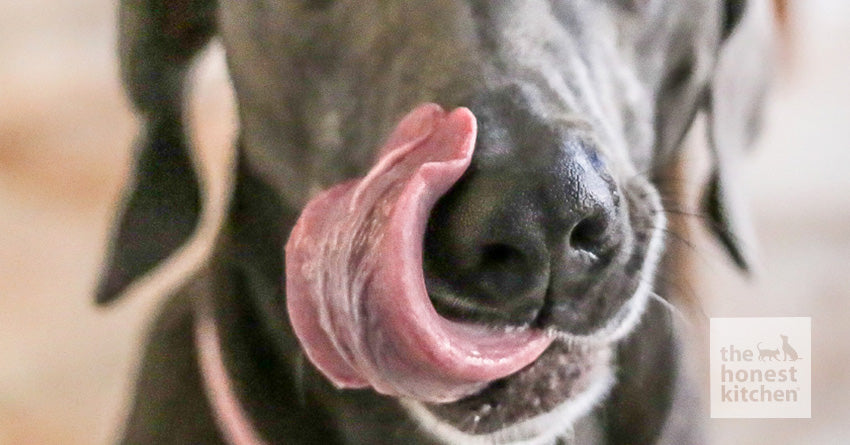These days, it's easy to feel overwhelmed by the sheer number of dog food brands on the market. Of course, you want to serve the healthiest food to your dog — but do you know what to look for?
Ultimately, what to look for in healthy dog food will boil down to many factors, including your pet's breed and activity level, overall health and wellness, life stage, and eating preferences. If you're like most dog owners, budget and convenience also come into play.
As you begin your search for pet food with high-quality ingredients, here are some things you should know.
What Is Considered Healthy Dog Food?
There's a lot that goes into determining whether any given dog food is "healthy." However, some helpful nutritional standards have been established by the Association of American Feed Control Officials (AAFCO). While AAFCO does not directly test, regulate, or approve pet food formulas to ensure that they meet their standards, they do set standard requirements and guidelines for the nutrients and ingredients that go into pet food.
If you look closely at a package of dog food, you should be able to find an AAFCO statement. This explains whether the formula contains essential nutrients that deem the food complete and balanced based on AAFCO standards.
Exact nutrient profiles for "healthy" dog food will vary based on your dog's life stage and other factors. For example, AAFCO guidelines for an adult dog food “maintenance” formula recommend:
- 18% protein
- 5.5% fat
- Minerals (including calcium, potassium, magnesium, and zinc)
- Vitamins (including vitamin A, vitamin D, vitamin E, and riboflavin)
It's also important for dog owners to understand that not all protein is created equal in the world of dog food, so simply choosing a high-protein formula isn't enough to ensure that the food is healthy. In order to keep a dog at a healthy weight, it's essential to have an animal-based protein as the number one ingredient. Lean proteins, such as fish and chicken, contain less fat than other protein sources and can promote a healthy weight.
Healthy Dog Food vs. Human Grade Dog Food
In simplest terms, labeling dog food as human grade means that every ingredient in the formula is considered human edible throughout the entire sourcing and production process. Likewise, it also means that the food is manufactured in a facility that meets the same quality and safety standards as human foods (under FDA Code 21 CFR 110).
As you can probably imagine, many companies refuse to create human grade pet food because it takes a lot more documentation and increases the costs of ingredients and production. However, companies that are passionate about high-quality nutrition understand that there isn't a higher standard than human grade.
On the other hand, human grade dog food doesn't automatically mean healthy dog food. After all, there are plenty of human grade ingredients (including corn, wheat, and soy) that are not ideal for pets to consume. However, most human grade dog food brands (like us at The Honest Kitchen) choose to also use high-quality, healthy ingredients. When done well, human grade pet foods include high-quality meats, real fruits and veggies, and only ingredients that are safe for people to eat as well.
A Note on Complete and Balanced Meals
The term "complete and balanced" is used to identify recipes that have been formulated to provide nutritional adequacy in pets. A complete and balanced recipe is safe to be fed daily, as you will know your pet is getting all the nutrients they need.
Complete and balanced dog food is based on AAFCO guidelines for proteins, fats, carbohydrates, vitamins, and minerals. As previously mentioned, an animal-based source of protein should always be the first ingredient in quality dog food.
If you choose to add toppers or supplements into your pet’s routine, it should only account for about 10% of their overall caloric needs. Relying too much on non-balanced foods like toppers or home-cooked products could mean that your pet doesn’t get the right balance of nutrients they need in their diet.
Dry Dog Food vs. Wet Dog Food
Both human grade and feed grade dog food are available in dry (kibble or freeze-dried) and wet or semi-moist formulas. And while there's a lot of debate over which option is the best dog food, the right choice for your pet will ultimately boil down to preference, as one isn't inherently better than the other.
Both wet and dry dog food options have several potential benefits and drawbacks. When it comes to kibble, many dog owners enjoy the convenience of being able to easily portion and pour food directly from the bag without worrying about spoilage.
On the other hand, many dogs prefer the taste and palatability of wet food to dry food. The aroma and flavor of wet food can be enticing, especially for picky eaters and senior dogs who may suffer from a decreased appetite. And, of course, wet food has a higher moisture content than dry food, so it's great for keeping dogs properly hydrated.
Ultimately, the types of food that are right for your dog will depend on your personal preference, your dog's preferences, and your budget. Dry food does tend to be more affordable than wet food, so many dog owners opt to feed a dry formula for most meals. Still, you might consider offering wet food as an occasional treat, incorporating it as a topper for dry food, or using a rotational feeding plan to get the best of both worlds.
3 Considerations When Choosing Healthy Dog Food
As you shop for the best food for your dog, you'll want to be aware of what makes a dog food option truly healthy. Below are three important considerations to make to help pet parents make better-informed choices.
1) “Eat the Rainbow”: Include Natural, Colorful Foods in Their Diets
You may have heard this term before regarding human diets. Essentially, “eating the rainbow” means eating foods that span a wide range of colors, from red tomatoes and orange sweet potatoes to green zucchini and purple broccoli. The basic idea here is that diversifying your food sources gives you a better chance of getting the right balance of vitamins and nutrients in your diet.
Incorporating fruits and veggies into your dog's diet can be a great way to provide them with essential vitamins, minerals, and fatty acids that strengthen their immune systems and improve overall health.
You can also use these colorful foods as healthy treat alternatives. Crunching on raw carrots, for example, can be a great way to strengthen your dog's teeth while adding some fiber and beta-carotene to your pup's diet. Meanwhile, fruits such as blueberries and cranberries offer vitamin C, vitamin K, and antioxidants that can support a strong immune system.
If you decide to add fruits and vegetables to your dog's diet, it's vital to understand which to avoid due to potential toxins or other dangers. Some examples of fruits and vegetables to avoid include:
- Onions
- Asparagus
- Grapes and raisins
- Avocado
2) Consider Your Dog’s Dietary Restrictions (if any) Rather Than Fad Diets
As a dog owner yourself, you may have noticed that there’s been a lot of discourse about grain-free dog foods made without wheat, corn, white and brown rice, and other grains. While these diets may have some merit for dogs with certain food allergies, sensitive stomachs, or other sensitivities, this dietary shift should only be made under the guidance of a veterinarian or veterinary nutritionist. Only a licensed professional can determine whether a grain-free, gluten-free, or other limited ingredient diet may be worth exploring under careful monitoring.
While a direct link has not yet been established, the FDA has investigated numerous reports of dogs suffering from a condition known as dilated cardiomyopathy (CDM) after switching to a grain-free or vegetarian formula. Specifically, the FDA received 515 reports of DCM in dogs between January 2014 and April 2019; 90% of these dogs were on a grain-free diet, while 93% of them were on diets that contained lentils or peas.
Aside from the potential connection between grain-free dog food and DCM, it's also worth noting that vegetarian dog foods can lead to a taurine deficiency. This deficiency often doesn't present any obvious symptoms, but it can cause swelling of the heart and slower metabolism, further highlighting the importance of consulting a veterinarian for any diet changes.
3) Focus on Protein Quality
What matters most in healthy dog food is that the number one item on the ingredient list is an animal-sourced protein. Protein is such a vital part of a dog's diet because it contains amino acids. Dogs require 22 amino acids to make their own essential proteins, but dogs can only make about half of these amino acids on their own. The other half must come from the food they're eating.
Of course, not all protein is created equal, as not all proteins are digested and processed in the same way by dogs. In general, lean, animal-based protein sources are best for dogs because they are easily digested without adding unnecessary fat or calories.
Similarly, the protein should come from whole muscle or organ meat — not in the form of by-products like chicken meal or beef meal. This ensures that the food has the nutritional value your dog needs. Opting for a high-quality human grade dog food company like The Honest Kitchen ensures that your dog gets the quality protein they need without unhealthy fillers and preservatives.
Feed Your Dog a Healthy Diet With The Honest Kitchen
Choosing a healthy dog food that coincides with your dog's tastes, your budget, and your lifestyle can feel like an overwhelming task. With this guidance in mind, it doesn't have to be. The Honest Kitchen is committed to nourishing pets with delicious and nutritious human grade formulas to help them feel their best. Find the right recipe for your dog today with our quick and easy quiz!
*Health Disclaimer: This post is educational in nature and doesn’t constitute health advice. Please consult your pet's veterinarian or other healthcare professional for specific guidance on this topic.

